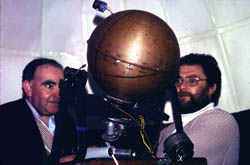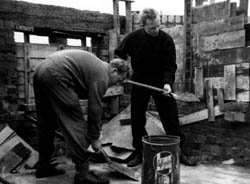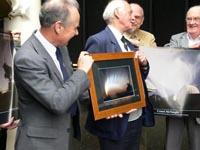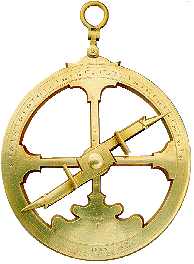Dundee Astronomical Society, 1956 - 2006 A Brief Look at DAS at 50
It all began in Dundee in 1956 when school friends Dave Gavine, Frank Mitchell and Harry Ford teamed up with veteran amateur astronomers the late Tom Flood and John Clark, to form a small club, and invited Morgan Academy physics master William Dow to be their first President. Ken Kennedy and Peter Waddell joined about a year later. They met once a month for informal talks in the Dundee Law Allotments Committee hut, under gaslight, and when it was clear they set up Tom’s 3-inch telescope outside, retreating to his cosy greenhouse with its welcoming stove when it became too cold to observe the moon and planets. During the next few years the Society moved around various premises, including a boys’ club and the Green’s Playhouse café, then they were allowed to meet in the Mills Observatory through the kind invitation of the Curator, Dr Jaroslav Cisar, whose popular Astronomy evening classes at the University proved invaluable.
T. Flood & H. Ford at the Mills ~ 1978
Dr Cisar was elected as the first Honorary Member. Among the many new faces were Bill Samson and Tom Lloyd-Evans. Dr Bill Samson, who was the Heritage Officer in charge of Mills Observatory for some years, and Dr Tom Lloyd-Evans, who, while still an undergraduate at St Andrews, captured on film one of the earliest and most detailed meteor spectra, then went on to a distinguished career in stellar astronomy in South Africa. Harry Ford became an informal assistant to Dr Cisar and soon became so adept at showing the public around the heavens that he became his successor, and when he was appointed full-time in 1972 he really put the Observatory on the map.
A lot of work was carried out under the guidance of Patrick Moore, a frequent visitor, in the search for Transient Lunar Phenomena (TLPs) for which the 10-inch Mills telescope was ideally suited.Harry became for a time Director of the Lunar Section of the British Astronomical Association (BAA), with Tom Flood, Morgan Findlay and Dave Taylor as his assistants. Tom enjoyed a new career as Assistant Curator of the observatory and wrote a short history of it. Meantime Ken Kennedy began his own lunar studies from his own observatory in Broughty Ferry. Successful meetings of the Lunar Section were held in Dundee in 1972 and 1974.
After many fruitful years Harry left to build his own planetarium in Southend then was appointed Planetarium Lecturer at the Old Royal Observatory in Greenwich, a post he held with great success. In 2000 he was made an Honorary Doctor of Science by Abertay University, and in 2003 was awarded an MBE for his work in promoting astronomy to the public. Now retired and living in Eastbourne with his wife Lynne (another astronomer) he takes a great interest in the DAS of which he is an Honorary Member, as was until his passing, Sir Patrick Moore.
During the International Geophysical Year of 1957-58 the DAS members decided to take part in the systematic study of the Aurora Borealis under the leadership of James Paton, who lived in Abernethy. James was the distinguished Director of the BAA Aurora Section and also of the Balfour Stewart Laboratory at Edinburgh University, one of the three World Centres for the study of the Aurora.
Powrie Observatory ~ 1962
This involvement of the DAS has continued ever since. James Paton was elected to be our first Honorary President. After his untimely death in 1975 this honour passed to the Rev Dr Cameron Dinwoodie, the Director of the BAA Computing Section whose work involved the calculation of orbits of newly-discovered comets. After his death in 1979 Dr Dave Gavine, sometime President of the Astronomical Society of Edinburgh and lecturer in charge of a college planetarium, was elected to become the third Honorary President. He became Director of the BAA Aurora Section in 2006, and Ken Kennedy, now (2007) astronomer at the Mills Observatory, became Assistant Director of the Section with special responsibility for recording observations of the Noctilucent Clouds (a phenomenon of the very high atmosphere) for UK and Western Europe.
In the early 1960s a member living in Fintry became aware of an old wartime pillbox on top of Powrie Brae which had great potential as an observing site. The DAS, led by the President, Bill Dow, approached the farmer, Mr Tom Pate, who allowed them to adapt this structure into a workable observatory and to use an empty bothy leading up to it. Timber, cement and other materials were obtained, a roof of two opening shutters and a balcony were built, and a magnificent telescope, which had been in the observatory of the late Mr W. B. Ogilvie of Carnoustie, was obtained on long-term loan from the BAA. The biggest problem was getting the massive iron pillar up the brae.Apart from the weight it tapered and when heaved up the hill with the aid of long levers and
bouts of non-scientific language it had a tendency to roll off the path. But it was a magnificent 4½ inch Merz refractor with near-perfect optics which performed wonderfully well on the Moon, planets and double stars. Many observations of Aurora and meteors were also carried out over the years when Powrie Observatory was active. The telescope was later moved to a run-off shed at Kirkinch. Dundee Astronomical Society has been responsible for actively promoting astronomy in other ways. Four members joined when they were young schoolboys, and Harry Ford, recognising their potential, encouraged them and taught them how to use the instruments. Robert McNaught, now a professional astronomer in Australia, has a world-wide reputation for his discoveries of Asteroids, Novae and Comets. Dr Neil Reid is an astronomer at Palomar, the discoverer of the then smallest-known star, Dr Colin Steele, a former Chairman of DAS, now works on theoretical solar physics at the University of Manchester, and Harry’s cousin, Dr Bill Allan, works on upper-atmosphere research for the New Zealand government. At the Mills, classes were run by Dave Gavine and others for members to take the GCE exams in Astronomy, all passing with flying colours.
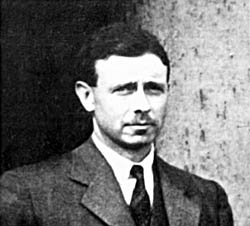
James Paton, First Honorary President of DAS
Lectures to the public were also given by DAS members, particularly during the celebrations of the lunar landings in 1969. Public exhibitions have also been held from time to time, featuring especially the excellent photographs taken by DAS member Dr Sandy McKenzie from his own home observatory.
In September 2006, the Society celebrated its 50th anniversary with a public lecture given by Professor John Brown, Astronomer Royal for Scotland. This was held in the University of Dundee and was organised in conjunction with the local branch of the Association for the Advancement of Science. Some weeks later, Dundee City Council provided a civic reception to mark the event. This was held at Mills Observatory, a building which has for so long been associated with Dundee Astronomical Society.
Honorary Members
The post of Honorary Vice–President was established within Dundee Astronomical Society in 1988 and awarded to Tom Flood, founder member of DAS and longtime assistant to Harry Ford at Mills Observatory. The next holder of the post was Bill Dow, first President of DAS, a respected teacher who was asked to become the first President by the founders of the Society. Harry Ford has now been asked to take the post and was pleased to accept, so becoming our third Honorary Vice-President.
Harry Ford was one of the founder members of DAS back in the late summer of 1956. He had an interest in astronomy from an early age and by the mid-1950s was making telescopes from anything he could get his hands on. In these days, astronomical telescopes were few and those which were available were extremely costly so Harry obtained ex WD lenses and improvised. These early telescopes were excellently made and showed the skills which Harry had and would put to good use later in his life. It was his early interest and also his contact with others with similar interests, our Honorary President among them, that saw the beginnings of the DAS.
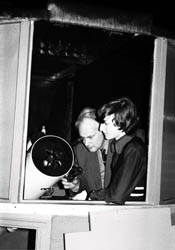
Patrick Moore & M. Fodor - 1974
Robert McNaught was a member of Dundee Astronomical Society in the 1970s and 1980s and spent much of his spare time at Mills Observatory until he graduated with an Astronomy degree from St Andrews University. He went on to become a professional astronomer and has been at Siding Spring Observatory, Australia, for some years. His work involves photography of the sky to identify asteroids which have orbits which cross that of Earth. In early 2007, an asteroid (No.6906) discovered by Rob was named by him in honour of John Mills.
Rob discovered Comet 2006 P1, known as Comet McNaught after its discoverer, in August 2006. It was seen in the UK for a few days in early January 2007 and Ken Kennedy photographed it on the 9th and 10th January from Broughty Ferry. By the time it passed into the southern hemisphere it had brightened considerably and is now believed to have been one of the brightest comets ever seen.
Robert McNaught has always been proud of his association with Mills Observatory and sent the print in order to acknowledge the encouragement he received there. The print which he presented to the Observatory is signed and has the legend: "To the folks at the Mills Observatory who inspired me from an early age."
Dundee Astronomical Society
Honorary Members since it's formation in 1956 |
| DAS Honorary Presidents |
| Name |
Date of election as Hon. Member |
Date of election as Hon. President |
| James Paton |
|
1956 |
| Cameron Dinwoodie |
1972 |
1974 |
| Dave Gavine |
1973 |
1980 |
| DAS Honorary Vice-Presidents |
| Name |
Date of election as Hon. Member |
Date of election as Hon.
Vice-President |
| Tom Flood |
|
1988 |
| Bill Dow |
|
2006 |
| Harry Ford |
1983 |
2014 |
| |
|
|
| DAS Honorary Members |
| Name |
Date of election as Hon. Member |
Deceased |
| Jaroslav Cisar |
1970 |
D |
| Walter Orr Roberts |
1970 |
D |
| Gavril Khromov |
1970 |
D |
| Thomas Lloyd-Evans |
1970 |
D |
| Richard Kennedy |
1970 |
D |
| Bill Samson |
1971 |
|
| Charles Bruce |
1974 |
D |
| Bill Allan |
1977 |
|
| Morgan Findlay (Darmachari Suvajra) |
1979 |
|
| Ron Livesey |
1980 |
|
| George Spalding |
1986 |
|
| Rob McNaught |
1988 |
|
| Neil Bone |
1991 |
D |
| Ken Kennedy |
2014 |
|
| Frank Mitchell |
Unknown |
|
| Colin Steele |
Unknown |
|
| Patrick Moore |
Unknown |
D |
| Sandy MacKenzie |
Unknown |
D |
A Brief History
